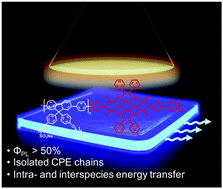当前位置:
X-MOL 学术
›
Mater. Chem. Front.
›
论文详情
Our official English website, www.x-mol.net, welcomes your
feedback! (Note: you will need to create a separate account there.)
Ureasil organic–inorganic hybrids as photoactive waveguides for conjugated polyelectrolyte luminescent solar concentrators
Materials Chemistry Frontiers ( IF 6.0 ) Pub Date : 2017-08-21 00:00:00 , DOI: 10.1039/c7qm00264e Ilaria Meazzini 1, 2, 3, 4, 5 , Camille Blayo 1, 2, 3, 4, 5 , Jochen Arlt 6, 7, 8, 9, 10 , Ana-Teresa Marques 11, 12, 13, 14, 15 , Ullrich Scherf 16, 17, 18 , Hugh D. Burrows 11, 12, 13, 14, 15 , Rachel C. Evans 1, 2, 3, 4, 5
Materials Chemistry Frontiers ( IF 6.0 ) Pub Date : 2017-08-21 00:00:00 , DOI: 10.1039/c7qm00264e Ilaria Meazzini 1, 2, 3, 4, 5 , Camille Blayo 1, 2, 3, 4, 5 , Jochen Arlt 6, 7, 8, 9, 10 , Ana-Teresa Marques 11, 12, 13, 14, 15 , Ullrich Scherf 16, 17, 18 , Hugh D. Burrows 11, 12, 13, 14, 15 , Rachel C. Evans 1, 2, 3, 4, 5
Affiliation

|
The development of an efficient luminescent solar concentrator (LSC), with minimised optical losses, requires careful consideration of its principal constituting materials, a waveguide and a luminophore, in tandem. Here, a series of LSCs are fabricated utilising a poly(fluorene-alt-phenylene) copolymer containing on-chain perylenediimide (PDI) chromophore units as the luminophore (PBS-PFP-PDI) immobilised within a poly(oxyalkylene)/siloxane organic–inorganic hybrid, known as a ureasil, as the waveguide. PBS-PFP-PDI and the ureasil both function as photoactive components, offering the possibility of energy transfer between the ureasil host and/or the PBS-PFP donor chains to the PDI acceptor, leading to reduced re-absorption losses and harvesting a broader wavelength range of the solar spectrum. A combination of studies using UV/vis absorption, Fourier transform infrared, steady-state and time-resolved photoluminescence spectroscopies revealed that the branching of the ureasil framework influences the packing of the polymer chains, with the tri-podal ureasil structure facilitating improved dispersion of the PBS-PFP-PDI chains, while the linear di-ureasil structure promotes more intimate mixing of the PBS-PFP-PDI and the ureasil. Picosecond time-correlated single photon counting measurements showed that strong spectral overlap, combined with efficient electronic coupling results in efficient excitation energy transfer from the ureasil to emissive trap sites localised on the PBS-PFP unit. This process inhibits subsequent energy transfer to the PDI chromophore, but leads to high solid-state photoluminescence quantum yields of >50%. The optical efficiency of the PBS-PFP-PDI–ureasil composites as LSCs was evaluated under AM1.5G solar simulated light delivering values of up to 5.6% using a scattering background, which could be boosted to 13.1% by increasing the percentage of PDI units per PBS-PFP chains using a model system. The results demonstrate that consideration of the combined photophysical properties of the luminophore and the waveguide are crucial to the design of next generation LSCs.
中文翻译:

Ureasil有机-无机杂化体作为共轭聚电解质发光太阳能聚光器的光敏波导
开发具有最小光学损失的高效发光太阳能聚光器(LSC),需要仔细考虑其主要构成材料,波导和发光体。在此,一连串的LSCs正在利用聚(芴制作ALT(亚苯基)共聚物含有在链苝二酰亚胺(PDI)发色团单元作为发光体PBS-PFP-PDI)固定在聚(氧化烯)/硅氧烷有机-内无机杂化物,称为尿素硅,作为波导。PBS-PFP-PDI尿素硅和尿嘧啶均充当光敏组分,从而使尿素硅主体和/或PBS-PFP供体链之间的能量转移到PDI受体成为可能,从而减少了重吸收损失并收获了更宽的太阳光谱波长范围。结合使用紫外线/可见光吸收,傅立叶变换红外光谱,稳态和时间分辨光致发光光谱的研究表明,脲硅骨架的支化会影响聚合物链的堆积,三足脲硅结构有助于改善聚合物的分散性。的PBS-PFP-PDI链,而线性二ureasil结构促进了更紧密混合PBS-PFP-PDI和尿素。皮秒时间相关的单光子计数测量结果表明,强大的光谱重叠以及有效的电子耦合可将有效的激发能从尿素硅有效转移到PBS-PFP上的发射阱位置单元。该过程抑制了随后的能量转移到PDI生色团,但导致了> 50%的高固态光致发光量子产率。PBS-PFP-PDI-脲醛复合材料作为LSC的光学效率是在AM1.5G太阳模拟光下使用散射背景评估的,其发光值高达5.6%,可以通过增加PDI单元的百分比将其提高到13.1%。使用模型系统的每个PBS-PFP链。结果表明,考虑发光体和波导的综合光物理特性对于下一代LSC的设计至关重要。
更新日期:2017-10-26
中文翻译:

Ureasil有机-无机杂化体作为共轭聚电解质发光太阳能聚光器的光敏波导
开发具有最小光学损失的高效发光太阳能聚光器(LSC),需要仔细考虑其主要构成材料,波导和发光体。在此,一连串的LSCs正在利用聚(芴制作ALT(亚苯基)共聚物含有在链苝二酰亚胺(PDI)发色团单元作为发光体PBS-PFP-PDI)固定在聚(氧化烯)/硅氧烷有机-内无机杂化物,称为尿素硅,作为波导。PBS-PFP-PDI尿素硅和尿嘧啶均充当光敏组分,从而使尿素硅主体和/或PBS-PFP供体链之间的能量转移到PDI受体成为可能,从而减少了重吸收损失并收获了更宽的太阳光谱波长范围。结合使用紫外线/可见光吸收,傅立叶变换红外光谱,稳态和时间分辨光致发光光谱的研究表明,脲硅骨架的支化会影响聚合物链的堆积,三足脲硅结构有助于改善聚合物的分散性。的PBS-PFP-PDI链,而线性二ureasil结构促进了更紧密混合PBS-PFP-PDI和尿素。皮秒时间相关的单光子计数测量结果表明,强大的光谱重叠以及有效的电子耦合可将有效的激发能从尿素硅有效转移到PBS-PFP上的发射阱位置单元。该过程抑制了随后的能量转移到PDI生色团,但导致了> 50%的高固态光致发光量子产率。PBS-PFP-PDI-脲醛复合材料作为LSC的光学效率是在AM1.5G太阳模拟光下使用散射背景评估的,其发光值高达5.6%,可以通过增加PDI单元的百分比将其提高到13.1%。使用模型系统的每个PBS-PFP链。结果表明,考虑发光体和波导的综合光物理特性对于下一代LSC的设计至关重要。











































 京公网安备 11010802027423号
京公网安备 11010802027423号